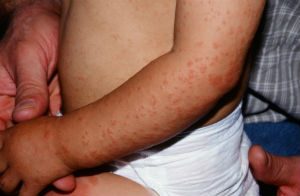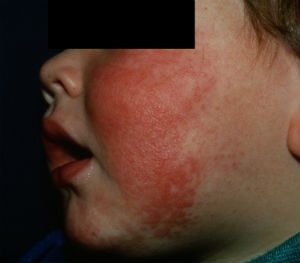Viruses can cause many widespread rashes on your child’s skin. Here’s some useful info to help you handle them.
Skin rashes develop from a variety of causes. In dermatology, a sudden rash that presents in many places or is widely spread we call “exanthema.” That’s a Greek word that means “a breaking out.” These rashes are very common, especially among children, and come from viral infections. Let’s take a look at some classic viral exanthema:
Measles (Rubeola): Some classic features of this viral rash are cough, conjunctivitis, coryza (rhinitis), fever and Koplik spots. Koplik spots are white little vesicles on a red base in the mouth. This highly contagious virus is spread by respiratory droplets and incubates in 10-14 days. Head-to-toe dense rashes can develop. Rarely this virus can cause pneumonia and encephalitis and can disseminate to internal organs such as the liver or gastrointestinal tract. Vaccination affords the most effective prevention.(2)
German Measles (Rubella): An early sign or symptom (prodrome) of fever, headache and upper respiratory symptoms may appear. Rashes presents on the face then on the body. Occipital lymphadenopathy (swelling of the lymph nodes back of the scalp and neck) is present. Birth defects occur within the first 16 weeks of pregnancy in a nonimmune pregnant woman. The current immunization schedule is at 12-15 months then at 4-6 years old.(2)
Scarlet Fever: A bright red rash that feels like sandpaper is a classic presentation of this virus. It may start out looking like a sunburn. The skin may peel around the toes, fingers and groin. Red streaks called pastia lines can occur in skin folds. The tongue may have a “strawberry” appearance, looking red and bumpy. A rapid strep test or throat swab may be necessary to obtain and an antibiotic prescribed. Complications from scarlet fever include kidney disease, rheumatic fever, otitis media and chronic sinusitis.(1)
Erythema Infectiosum (slapped-cheek or 5th disease): This virus peaks during the winter and springtime. Caused by parvovirus B19 infection, this skin eruption presents with a lacy-patterned rash on the limbs and a bright red rash on the face. The B19 infection occurs worldwide and is found most commonly in school-aged children. An exposed fetus can develop hemolytic anemia, hydrops (abnormal accumulation of fluid in 2 or more fetal compartments), or stillbirth. If a pregnant woman is exposed to the virus within the first two trimesters, serial fetal ultrasonography is recommended.(2)
Roseola: This is primarily caused by herpesvirus-6 (HHV-6) and usually occurs between 6 months to 3 years of age. A high fever ensues for 3-5 days. As the fever subsides, rose-pink maculopapular rashes occurs on the trunk, neck, extremities and face. This skin eruption abates over the course of 3-4 days. Many studies have linked Drug Rash with Eosinophilia and Systemic symptoms (DRESS—a serious adverse drug reaction involving multiple organs and high fever) with the reactivation of HHV-6.(2)
Coxsackie Viruses: Hand, foot and mouth disease is caused by the coxsackie virus A16 and herpangina is caused by coxsackie A virus. Coxsackie viruses usually affect children younger than 5 years old. A fever, sore throat and a general feeling of fatigue occurs. Painful sores then develop in the mouth 1-2 days after the fever starts (herpangina) or red spots with blisters occur on the palms and soles, possibly the knees, elbows, buttocks or genital area (hand foot and mouth). Viral meningitis and encephalitis can rarely result from hand, foot, and mouth disease. Fingernail and toenail loss is common among those with hand, foot and mouth disease. Treatment is supportive.(3)
Gianotti-Crosti:  Typically caused by the Epstein-Barr virus, there has been an association with hepatitis B virus and other viruses found in children 6 months to 14 years old. Spring and early summer are the primary seasons this found more commonly. Pink-red to flesh-colored papules (sometimes vesicles or purpuric lesions) occur on the face, buttocks and the extremities. Topical steroids are sometimes helpful. Spontaneous resolution occurs anywhere from 3-8 weeks.(2)
Typically caused by the Epstein-Barr virus, there has been an association with hepatitis B virus and other viruses found in children 6 months to 14 years old. Spring and early summer are the primary seasons this found more commonly. Pink-red to flesh-colored papules (sometimes vesicles or purpuric lesions) occur on the face, buttocks and the extremities. Topical steroids are sometimes helpful. Spontaneous resolution occurs anywhere from 3-8 weeks.(2)
References:
- Blahd, W. (2017). Understanding scarlet fever. WebMD. Retrieved July 9, 2017 from webmd.com/a-to-z-guides/understanding-scarlet-fever-treatment
- Bolognia, J., Jorizzo, J.L., & Schaffer, J.V. (2012). Dermatology (3rd ed). Philadelphia: Elsevier Saunders.
- Hand, foot, and mouth disease (2017). Centers for Disease Control and Prevention. Retrieved July 9, 2017 from https://www.cdc.gov/hand-foot-mouth/index.html


